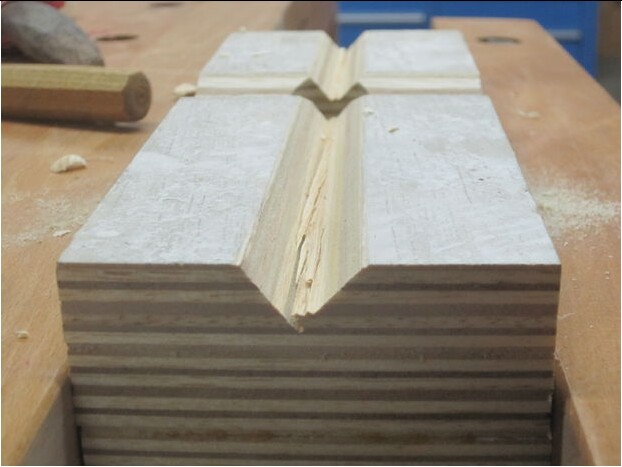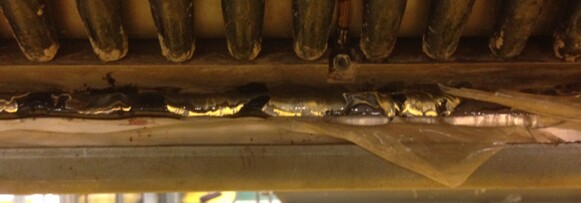Processing Tips to Prevent Gauge Bands - Part 3
- Published: May 26, 2014, By Tom Bezigian
Now that we have successfully started up the extruder, and run it properly so as to avoid gauge bands, now it's time to discuss properly shutting down the machine. This part is fairly straight forward and simple, and is more or less the reverse of starting up. Here again, it is essential that screw speed be kept at a minimum of 30 RPM so that the polymer acts as a coolant to the parts of the machine that do not have cooling zones. By this I mean the adapter, piping, coex feedblock and the die. The extruder zone quite often have built in cooling capability so that the extruder will cool down faster than the components after the extruder head. Slowing down the RPM while cooling down will, in addition to degrading the polymer in the die land area, will extend the shutdown procedure by hours.
DISCLAIMER: The following recommendations are general guidelines that are applicable to most extrusion coating lines using modern equipment, processing low density polyethylene (LDPE). Your equipment or materials may require special conditions not covered here. Be sure to consult with your resin supplier, machine supplier or technical experts to ensure that these conditions are applicable to your equipment and materials. Improper start-up procedures have been known to damage equipment and/or cause explosions.
Okay, so you've run all you're products, and have scheduled a shutdown. What do you do?
A) Just turn the extruder off and go home?
B) Plug the die with a drool stick, turn the extruder off, then go home? Or...
C) Reduce temperatures gradually, plug it with a drool stick when the temperatures are low enough, then shut the machine off and go home?
A is the wrong answer. B is acceptable, but not perfect. C is the desired shutdown method. The reason that it is desirable to reduce temperatures then plug the die with a drool stick should be obvious by now. At 230°, the decomposition rate of LDPE is sufficiently low that the extruder can be shut off with little worry of decomposition. Proper placement of the drool stick will prevent oxygen from entering the die land area, thus minimizing the chances for oxidation and degradation of the polymer in this critical part of the die.
The influence of temperature is described by the Arrhenius equation,  .
.
As a rule of thumb, reaction rates for many reactions double for every 10 degrees Celsius increase in temperature. Therefore, on the average, reaction kinetics would tell us that the decomposition rate of LDPE at 230°C is 2 to the 8th power, or 256 times, slower than at 310°C.
Lower temperature is nearly always desirable, but there is a point where there is a trade-off between lower rate of polymer degradation and a higher risk of tripping the extruder motor or rupturing the "blow-out" plug at the end of the extruder, and 230°C seems to be that point.
And, as a point of reference, a drool stick is merely a (preferably) piece of wood with a V-groove machined into it (see photo below), covered with Teflon tape that is somehow or another supported underneath the die so as to catch and accumulate the final few seconds of drool before the extruder screw is finally turned off (as shown below). Usually a stand is used to support the drool stick, but I have seen spring loaded mechanisms attached directly to the die. Another variation is a metal angle iron on a spring stand. I prefer wood as the chance of damaging this precious piece of metal is much lower than with metal. To each his or her own.
Close up of wooden part of a drool stick.

Okay, back to the shutdown part of the shutdown procedure. If you are experienced and disciplined and will not leave the machine, and will personally observe the shutdown process, you can simply set the zone temperatures as desired (shown below), and maintain 30 RPM until they are reached, slow the RPM down to 5 RPM, put the drool stick in place, fill the void so that there is not air gap between the die and the molten polymer pool you've just created then turn the extruder off.
Recommended shutdown temperatures:

If your operators are inexperienced or if you must follow a procedure to be ISO compliant, here is a step by step outline of how to shut off the extruder.

With the extruder in the offline position, drool at 30 RPM as shown in Step 1 (this should be your standard operating conditions as discussed in this article series). Reduce temperatures as shown in Step 2, and continue drooling at 30 RPM until these new setpoints are reached. This typically takes 30 minutes or so. At that point reduce temperatures as shown in Step 2 and continue purging/drooling until the new setpoints are reached. Once all temperatures have stabilized at those indicated in Step 3, reduce the screw speed to 5 RPM and prepare to install the drool stick according to in-house or machine manufacturer's recommendations. Once in place, fill the void between the drool stick and the bottom of the die with molten polymer. It should look something like shown below.

Once this is done, turn the extruder off.
Next time, polymer stabilizers to aid in reduced gauge bands.









